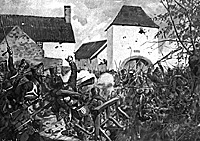 The Prussian role in the battle of Waterloo is often overlooked or minimized in English language sources. Basically, the classic version has the Anglo-Allied Army barely hanging on to defeat the French, with the Prussians arriving just in time to mop up. This article will describe the Prussian role in more detail and hopefully will help to make the Prussian contribution better known.
The Prussian role in the battle of Waterloo is often overlooked or minimized in English language sources. Basically, the classic version has the Anglo-Allied Army barely hanging on to defeat the French, with the Prussians arriving just in time to mop up. This article will describe the Prussian role in more detail and hopefully will help to make the Prussian contribution better known.
Setting the Scene
The Prussian Army of the Lower Rhine consisted of four army corps, each consisting of four infantry brigades (approximately equivalent in strength and firepower to a French or British Division), a Reserve Cavalry, usually of three brigades, and a Reserve Artillery. The army had been brought up to a war strength of around 140,000 men despite manpower shortages and the difficulties of a rapid mobilization. Several units or parts of units were still in transit at the start of the campaign.
The army was led by Field Marshal Prince Blücher von Wahlstadt, a seventy-year old veteran soldier beloved by his troops. Blücher was energetic and full of drive despite his years. His fanatical devotion to the spirit of his orders, his determination to cooperate with Wellington and his army to defeat the French, and his skill at handling his subordinates were to prove critical during the campaign.
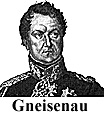 Blücher's skillful handling of people is well illustrated by his almost symbiotic relationship with his brilliant chief-of-staff, General Graf von Gneisenau. Gneisenau was also chief of the Prussian general staff and as such was more than a mere assistant to Blücher. He was also an advisor, assistant and, after the battle of Ligny, a most competent surrogate. The corps commanders were von Zieten, von Pirch I (succeeding von Borstell), von Thielemann (a Saxon who had served under Napoleon) and von Bülow. All were competent veterans who had served in the Wars of Liberation in 1813-14.
Blücher's skillful handling of people is well illustrated by his almost symbiotic relationship with his brilliant chief-of-staff, General Graf von Gneisenau. Gneisenau was also chief of the Prussian general staff and as such was more than a mere assistant to Blücher. He was also an advisor, assistant and, after the battle of Ligny, a most competent surrogate. The corps commanders were von Zieten, von Pirch I (succeeding von Borstell), von Thielemann (a Saxon who had served under Napoleon) and von Bülow. All were competent veterans who had served in the Wars of Liberation in 1813-14.
Scattered
The French crossing of the frontier on 15 June found the Prussian corps scattered from Charleroi and Dinant back to Liege, through which ran the Prussian line of communications. However, reports from French deserters had resulted in orders being issued to concentrate the army in the vicinity of Sombreffe. Three corps rendezvoused at that location by the morning of the 16th while von Bülow's IV Corps hastened forward from its rear position around Liege. Believing that Wellington would concentrate at Quatre-Bras and support any Prussian action, the Prussians offered battle.
This battle, known as Ligny by the Allies and referred to as the Battle of Fleurus by the French, resulted in a Prussian defeat when Napoleon pierced the Prussian center with a devastating attack by the Old Guard.
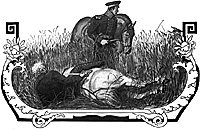 During this battle, Blücher led a cavalry attack to cover the retreat in person and falling from his horse, became hors de combat. With Blücher absent from headquarters and nowhere to be found, von Gneisenau faced an agonizing decision. Should the Prussian army, which was retreating in relatively good order, fall back on its lines of communications through Liege or toward the northwest to maintain contact and cooperation with Wellington?
During this battle, Blücher led a cavalry attack to cover the retreat in person and falling from his horse, became hors de combat. With Blücher absent from headquarters and nowhere to be found, von Gneisenau faced an agonizing decision. Should the Prussian army, which was retreating in relatively good order, fall back on its lines of communications through Liege or toward the northwest to maintain contact and cooperation with Wellington?
Despite his coldness toward the British, von Gneisenau remembered the spirit of Blücher's orders and decided that the retreat should proceed northwest toward the town of Wavre on the Dyle river. Coupled with the lack of a French close pursuit, the Prussians would be in a good position for the actions taking place over the next two days.
By evening, the Prussian army had begun to sort itself out from the confusion of the day's fighting. Around midnight, Blücher was located. The old hussar approved of Gneisenau's orders and was anxious to re-establish contact with Wellington. On the 17th, as Prussian units began to gather about the vicinity of Wavre, contact with Wellington was resumed. The 17th was spent resupplying and reorganizing the troops. Plans for joint action were finalized with Wellington. The British planned to hold in the vicinity of Mont St. Jean. Blücher resolved to go to Wellington's support.
By midnight on 17 June, Blücher had received firm assurance of Wellington's intentions for the 18th. Orders were issued to the IV Corps, the freshest of the Prussian units, to proceed at daybreak through Chapelle St. Lambert and vigorously attack the French right flank if the enemy were engaged with the British. If the French were not engaged, von Bülow was to wait under cover until the French were committed against Wellington. Von Pirch's II Corps was to follow in support. At this time, both I and III Corps were ordered to remain in readiness to follow in support but no definite movement orders were issued to the two corps. The Prussians needed to be certain their flank along the Dyle was secure against Grouchy's pursuing forces.
The Approach March
As von Bülow’s troops began their march on the morning of 18 June, two critical factors began to delay the arrival of the Prussians on the battlefield. The first was the effect of the torrential downpour of the 17th on the route between Wavre and Mont St. Jean. The rain turned the road into a quagmire. The area was crossed only by paths which hardly merited the appellation "road" and was traversed by deeply cut streams whose banks were most difficult to cross.
The second factor was the concentration of the Prussian army in the small area around Wavre. The town soon became a bottleneck. The IV Corps had to make its way through the squeeze of Wavre and then through the bivouacs of II Corps before they could be on their way. Both factors were to delay the Prussian arrival dramatically.
The IV Corps set out that morning with its 15th Brigade in the van. Following behind were the 16th and 13th Brigades and then the Reserve Artillery. The guns were followed by the Reserve Cavalry. The rearguard was provided by the 14th Brigade. The 15th Brigade stepped out briskly between five and six in the morning and, despite rough going, reached St. Lambert between nine and eleven that morning. The main body was held up in Wavre by a fire and did not reach St. Lambert until midday, opening up a considerable gap in the IV Corps line of march. The rearguard did not reach St. Lambert until three that afternoon. This delay backed up the II Corps which could not get on the road until midday.
At about eleven that morning, Blücher set off to accompany his IV Corps. At the same time, orders were issued to I Corps to proceed via Froidmont and join up with Wellington's left flank. Due to road congestion in and about Wavre, this corps was not able to start its march until 2 p.m. III Corps was to remain as a rearguard in the vicinity of Wavre.
When Blücher arrived at St. Lambert at about noon, he found the bulk of IV Corps there. He urged the troops forward across the Lasne stream and into the Bois de Paris. Reconnaissance by Bülow’s Silesian Hussars had shown this area to be clear of the enemy. It was imperative to secure this ground as even a small French force could seriously delay the Prussians here.
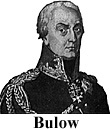 The IV Corps gathered in the Bois de Paris without any serious opposition and Bülow planned to await the arrival of his 13th and 14th Brigades prior to launching his attack. It was his troops moving into position which Napoleon spotted from his vantage point. Except for the two lagging brigades, Bülow was in position by 3 p.m.
The IV Corps gathered in the Bois de Paris without any serious opposition and Bülow planned to await the arrival of his 13th and 14th Brigades prior to launching his attack. It was his troops moving into position which Napoleon spotted from his vantage point. Except for the two lagging brigades, Bülow was in position by 3 p.m.
The Prussian Attack
At this point (about 4-4:30p.m.), Blücher, noting the activity against the Allied line, ordered Bülow into the attack without waiting for his remaining forces. It was more important to bring some pressure against the French than await the rest of the corps. Moving against French screening cavalry and the arrival of Lobau's VI Corps, Bülow’s right, consisting of the 15th Brigade soon supported by the 13th Brigade, engaged the French VI Corps. The left, comprising the 16th Brigade, attacked the pivotal village of Plancenoit. Lobau, fearful of his flanks, withdrew to the heights just to the left rear of Plancenoit, and the 16th Brigade ousted the small French force left there at about 6 p.m.
This victory was short-lived. Napoleon had dispatched the Young Guard of eight battalions, supported by 24 guns, to retake the village. They handily expelled the exhausted Prussians from the village. Although the Prussians quickly counterattacked, the Guard held on and the Prussians regrouped as the 14th Brigade finally began to arrive.
Meanwhile, Zieten's I Corps had begun to approach Wellington's left flank near Ohain. Blücher ordered him to change direction and proceed in the direction of Plancenoit. With his vanguard about to deploy in support of the hard-pressed Allied left, Zieten, after much consideration, decided to disregard the change of orders and go into action near Ohain. This decision probably saved the Allied left from complete collapse as it was at the end of its tether and units had already been moved to the center.
Just after 6 p.m., the Prussian IV Corps began to falter. Its right (15th and 13th Brigades) was in contact with the French VI Corps from Frischermont to just outside Plancenoit. Its right (16th now supported by 14th Brigades) formed for a new attack on Plancenoit. Since the corps was spread over a wide front, its numerical superiority could not be brought to bear. There could be no main point of attack. The next attack went in at Plancenoit at about 6:30 and was again repulsed. Durutte was now supporting Lobau and the IV Corps' right flank felt the pressure.
Another attack was sent against Plancenoit. This time, the mixed force, formed from a nucleus of the 14th Brigade, managed to oust the Young Guard from Plancenoit. Napoleon noticed this threat to his right flank and at 6:30, dispatched two Old Guard battalions to restore the situation. By seven, they had retaken the bloody streets of the village. The Prussian IV Corps, although it had not managed to make much headway, was tying up a considerable amount of French troops, which could have been used decisively elsewhere.
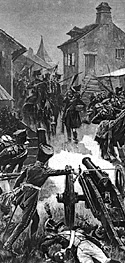 At about 7 p.m., the first attack of the Prussian I Corps struck Durutte's Division and eased the pressure on IV Corps' right flank. This took the French completely by surprise. La Haye and Papelotte were recaptured by the Prussians. The French right began to waver. At this point, the main body of the French Middle Guard attacked the British and were repulsed. The combination of events proved too much for the French. Durutte and Marcognet's Division to his left began to crumble.
At about 7 p.m., the first attack of the Prussian I Corps struck Durutte's Division and eased the pressure on IV Corps' right flank. This took the French completely by surprise. La Haye and Papelotte were recaptured by the Prussians. The French right began to waver. At this point, the main body of the French Middle Guard attacked the British and were repulsed. The combination of events proved too much for the French. Durutte and Marcognet's Division to his left began to crumble.
Just after 7 p.m., the leading elements of Prussian II Corps began to arrive behind IV Corps. The Prussians prepared to once more assail Plancenoit. The II Corps' relatively fresh 5th Brigade spearheaded the new effort. In vicious house-to-house fighting lasting an hour and a half, the French Guard were driven from Plancenoit, this time for good.
Darkness now began to fall over the battlefield. The French were in retreat everywhere. Blücher began to organize pursuit from his remaining units.
Conclusion
How decisive was the role played by the Prussians? At the height of the afternoon fighting, the IV Corps faced ten battalions of Guard, the French VI Corps and Durutte's Division. This was a significant amount of force that was not available to Napoleon to pierce Wellington's wavering line. In addition, the attack of the Prussian I Corps at about 7-7:30 unhinged the French line. The right flank of d'Erlon's Corps was dispersed and this exposed both the balance of d'Erlon's command and Lobau's left flank. The French disintegration can be said to have started at this point although the Prussian attack was not the sole cause of the disintegration. Finally, the pursuit organized by the Prussians after the French collapse prevented the French army from rallying. Whether it could have rallied without an aggressive Prussian pursuit is not the issue. The point is that it was never given the chance.
Sources
Chalfont, Lord, ed., Waterloo, Battle of Three Armies, A.A. Knopf, NY 1980.
Eckhardt, Obstlt. a. D. W., Warum muss die Schlacht von Belle-Alliance einen Preussischen Sieg nennen?, Zeitschrift fr Heeres- und Uniformkunde, 1940, p.12.
Nofi, A. A., The Waterloo Campaign, Combined Books, PA, 1993.
Related:
Back to Empires, Eagles, & Lions Table of Contents #12
Back to Empires, Eagles, & Lions List of Issues
Back to MagWeb Master Magazine List
© Copyright 1995 by The Emperor's Press
[This article appears in MagWeb (Magazine Web) on the Internet World Wide Web.
Other military history articles and gaming articles are available at http://www.magweb.com]